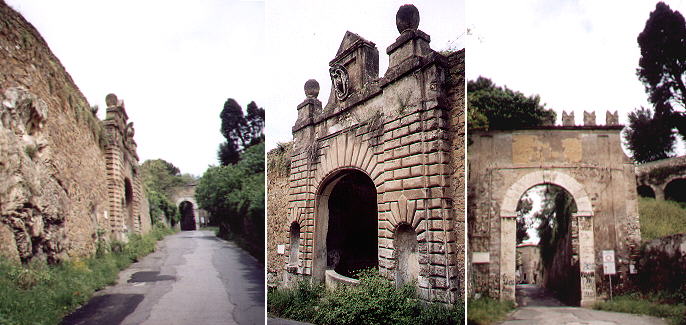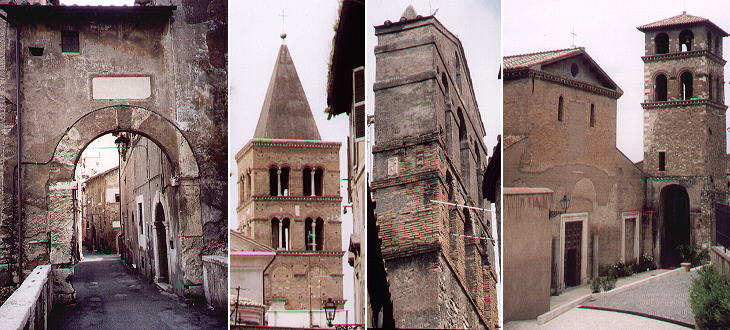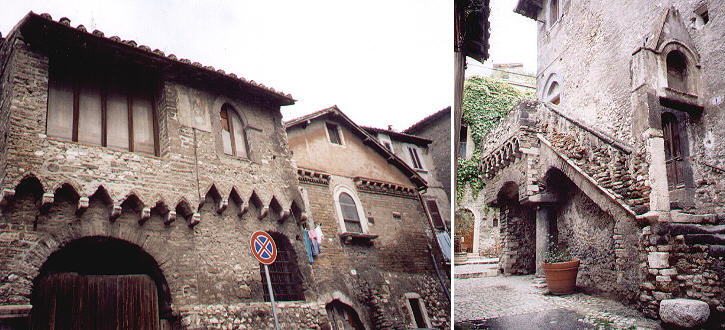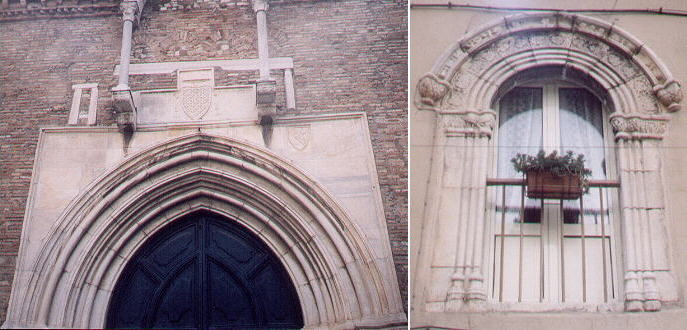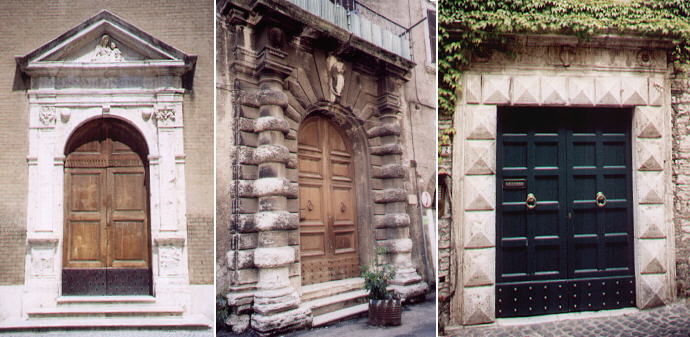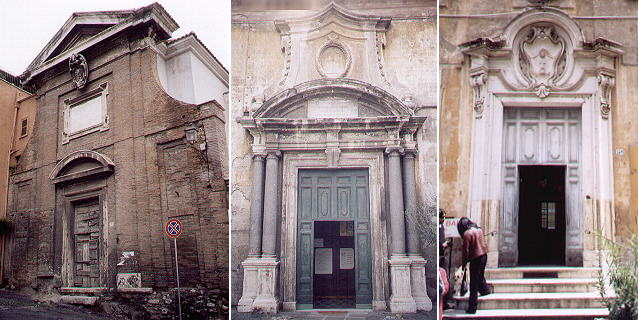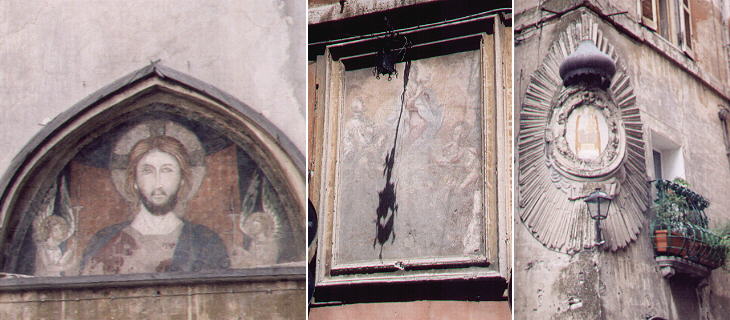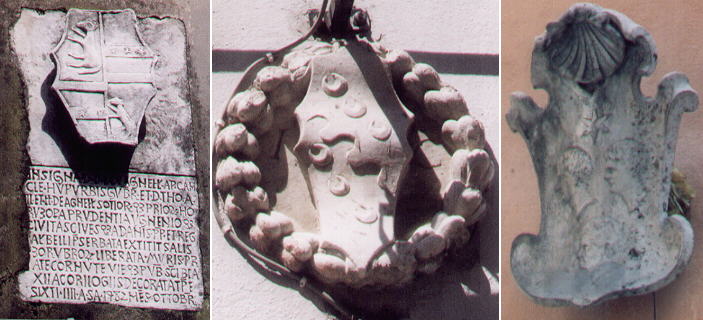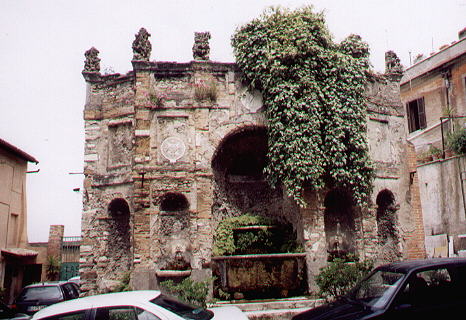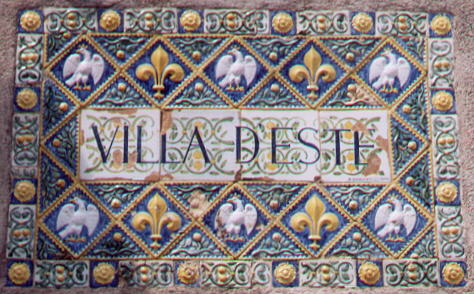  Giuseppe Vasi's Digression - Tivoli - part two: Medieval, Renaissance and Baroque periods
In the general decadence of the Italian towns after the fall of the Roman Empire,
Tivoli is an exception, as the site of the medieval Porta del Colle indicates. The new gate marks an expansion of Tivoli beyond the ancient Roman town.
In the XIIth century Tivoli sided with the German Emperors in their fight against the Pope and it tried to become the most important town of Latium, but
owing to the death in 1250 of the Emperor Frederic II and the consequent weakness of the imperial party, Tivoli lost its independence in 1259.
It remained however a wealthy town in the following centuries and it had a period of splendour in the second half of the XVIth century when Cardinal Ippolito d'Este
was appointed governor of the town.
Many Italian towns have retained their old medieval gates, but it is pretty unlikely that they have retained the old road leading to the gate. This occurs in Tivoli, where the road leading to the Porta del Colle is not spoiled by modern buildings. This is due to the fact that there are new roads linking Rome with Tivoli. The pictures above show also a large fountain built by Cardinal Ippolito d'Este as a sort of anticipation of its nearby Villa.
Tivoli has a remarkable medieval heritage in particular in the quarters Castrovetere (old castle) and Colle (hill). The bell tower of the cathedral goes back to the XIIth century and together with the number of churches, it is a sign of the importance of the town.
The buildings near Porta del Colle offer a variety of medieval architecture which in Latium can only be compared with that of Viterbo.
S. Maria Maggiore is another medieval church which has a fine Gothic portal. Above it there is the coat of arms of a cardinal because the church was next to the cardinal's residence. It was this residence that Cardinal Ippolito d'Este turned into a Renaissance villa. In a page on the windows of Italy there are two interesting windows of Tivoli, but I thought the window in the picture above deserved being shown too.
Tivoli has also several interesting Renaissance monuments: the church of S. Biagio in today's city center was rebuilt in the XIXth century but it retains a portal of harmonious proportions. The portal of Palazzo Piccolomini was designed having in mind a pattern of columns which were in fashion in the Ist century A.D. at the time of the Emperor Claudius. The third Renaissance portal shown above is decorated with a "diamond" pattern, which can be seen in Rome in Palazzo Santacroce, but which is typical of Palazzo dei Diamanti in Ferrara, the town of the Este. Pope Pius II, Enea Piccolomini, built the fortress you see in the background of this page (click here to see it in a page on the Fortresses of the Popes).
Baroque monuments are relatively few when compared with the medieval and Renaissance ones. The Villa built by Cardinal d'Este was a model followed by many other cardinals and popes, but they chose to build their villas in Frascati, Castelgandolfo and other towns of the Castelli Romani, rather than in Tivoli. This explains why the only Baroque additions one can see in Tivoli are related to religious buildings.
Tivoli has many sacred images of different periods: the sequence of sacred images shown above shows the development in framing these images from the very simple medieval approach to the elaborate XVIIIth century stucco aedicule.
The sequence of images above show how the design of coats of arms developed. At first it had a shape similar to a shield, then the shield was combined with a circle as the Renaissance privileged "pure shapes" and eventually it adopted the elaborate curved lines of the Baroque period. The Cenci were one of the most important Roman families in the XVIth century and they had many possessions in and around Tivoli, including the castle of Petrella Salto, where in 1599, Beatrice Cenci and her brothers arranged the killing of their father Francesco.
XIXth century foreign travellers all made comments about the poor state of the fountains of Villa d'Este. They found them however very picturesque: having come to Italy chiefly to see the ruins of Ancient Rome, they eventually loved all kind of ruins. The fountain shown above can give an idea of how those of Villa d’Este once looked, because today, after a lengthy restoration, they have been brought back to their pristine splendour.
Let's move to Villa d'Este See my Home Page on Baroque Rome or my Home Page on Rome in the footsteps of an XVIIIth century traveller. |
All images © 1999 - 2004 by Roberto Piperno. Write to romapip@quipo.it
